Flower Show Judging Guidelines
JUDGING BLOOMS AND AWARDING RIBBONS
Judges will determine whether or not a particular bloom is true to type in form, size, color and substance, then review the condition of the bloom and determine the award to be given.
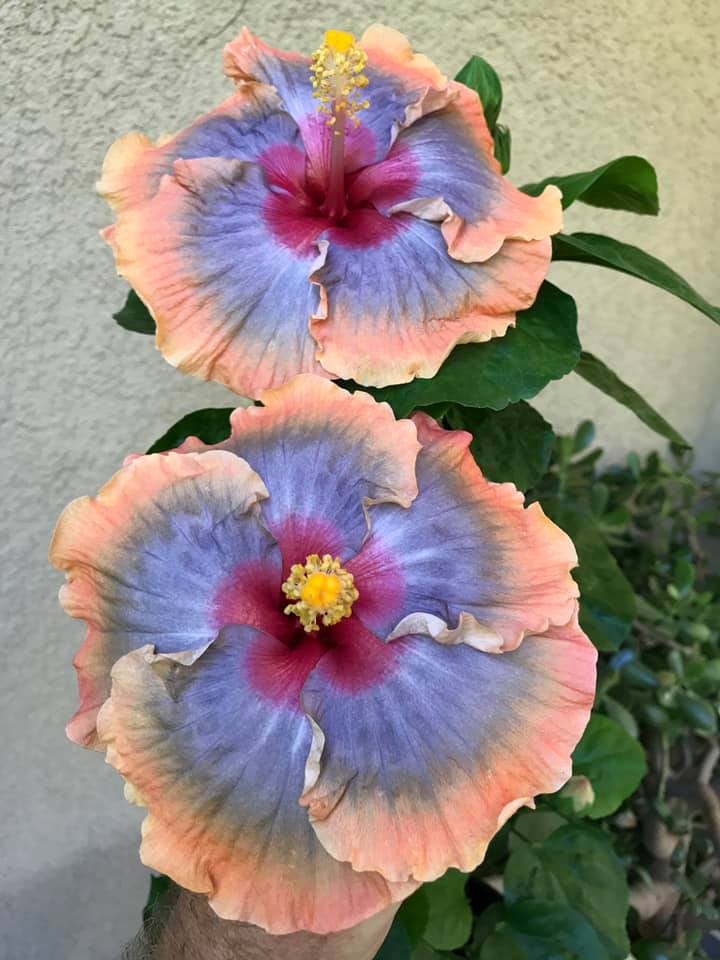
Circle of Life – Hidden Valley Hibiscus photo courtesy of Thomas Narolewski
STANDARD OF EXCELLENCE
FORM: Refers to shape and symmetry of petals. A bloom that is asymmetrical may receive a Gold Seal award if such is typical of that variety.
SIZE: Refers to size of blooms from average garden-grown plants and not necessarily to over-sized blooms.
COLOR: Refers to colors typical for normal warm-weather blooms, as that is when colors are the truest.
SUBSTANCE: Refers to the normal material of petals for that variety and includes freshness of texture. Thin or soft texture is not desirable if due to poor quality for that variety.
CONDITION: Refers to damage from:
W – Weather
I – Insects & Disease
S – Spraying
H – Handling
A 10-point system is used in scoring:
FORM
SIZE
COLOR SUBSTANCE CONDITION
Ribbon Award Scoring:
Gold Seal Ribbon: Perfect Bloom 9-10 points
Blue Ribbon: First Place 7-8 points
Red Ribbon: Second Place 4-6 points
All blooms start with 10 points and then points are deducted for each imperfection observed and noted by a judge. Judges keep their own score card for each entry and then judges compare their scorecards for that entry to agree on the ribbon award for it.
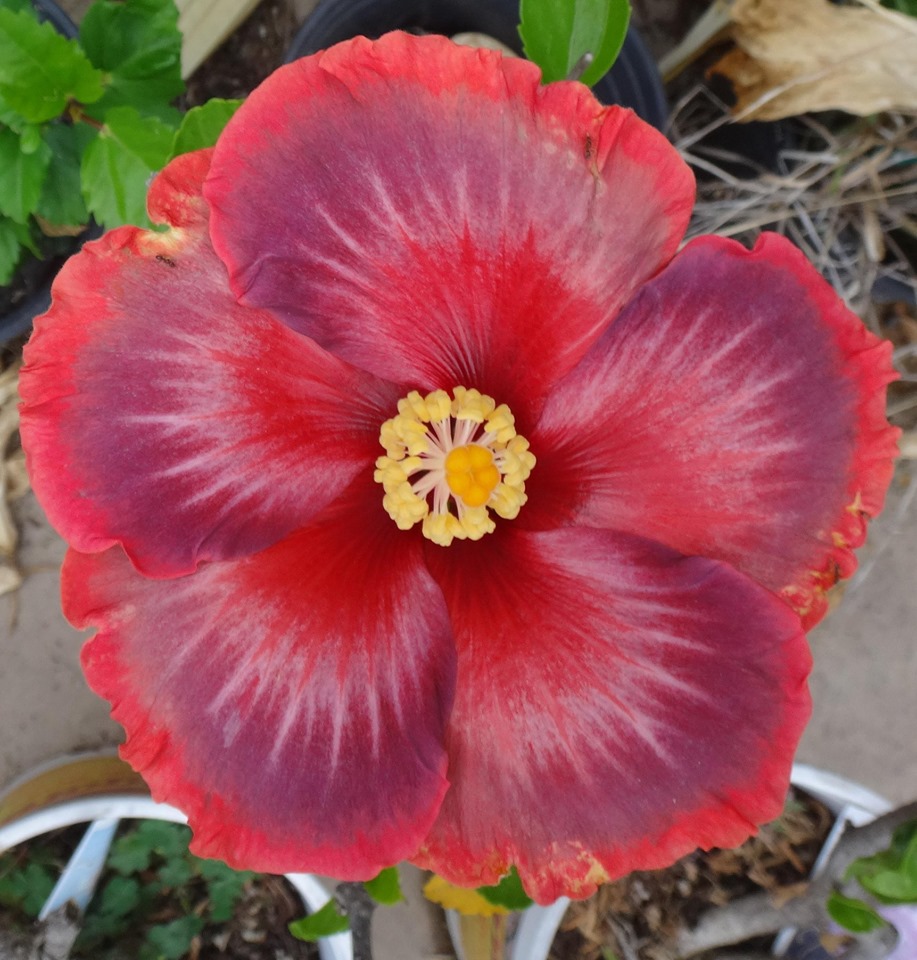
Oleta Pearl hybridized by Pushpa Suresh photo courtesy of Bill Schmidt
JUDGES’ STANDARDS
1. Judges may judge at their own show only with permission of the Show Chairman.
2. Judges should wear their badges at shows when judging for identification purposes.
3. All decisions of the Judges will be final. The SCHS Show Director with the Show Chairman may request an amendment of that team.
4. Judges MAY NOT look at the exhibitor’s name or number on the entry tag. All tags should be properly closed before time of judging.
5. Gold Seal awards shall be designated only by the team judging that bloom.
6. Judging should be done with trained eyes—not by touch.
7. Judges should not discriminate among the types of blooms because of personal prejudices about variety, size, color, or hybridizer.
8. Judges should not change the names of blooms on entry tags. Blooms entered with wrong names on entry tags shall be called to the attention of the Show Director, and the exhibitor shall then have the name changed. The bloom will then be considered for an appropriate award with no penalty. If time is a factor, a notation may be made on the upper corner of the tag as to the proper name.
9. When a bloom is assigned an “X,” if time permits, an explanation of the reason for the X will be made on the exhibitor card.
10. When a team of Judges receives a tray of blooms seemingly entered by one of the Judges on the team, those blooms should be given to another table to judge.
11. The Tally Clerk should inform the Show director if he/she sees that a judge is repeatedly judging his/her own blooms. If this occurs, a warning will be given by the Show director and the Judge will be asked to leave the table for the duration fo the judging process. On the second offense, blooms will be disqualified, and the judge will lose judging credentials for 2 years.
12. Blooms will be judged in the order they arrive and will be returned to the exhibitor only for clerical error, i.e., a wrong name or, if time permits, to be more fully opened.
13. Judges should not enter the Gold Seal area prior to judging, and should remain apart from entry and placement tables to assure unbiased judging.
14. Persons not directly involved in the judging process must not be in the judging area during any part of the judging process.
15. It is the responsibility of the Receiving Judge to make sure that all blooms exhibited on a miniature card pass through the 5” ring by passing the ring straight down over the bloom
16. Judges should not discriminate against doubles because of lack of symmetry if it is typical of that variety.
17. A bloom that grows as either a single or a double shall be judged as entered, i.e., as it is blooming on that day. However, only one bloom of the variety (either the single or the double) may be entered in each show by each exhibitor.
18. Judges do not judge their own blooms at any time with the exception of the Miniature category in initial Gold Seal judging only.
When entering the judged blooms on the tally sheet, if the Tally Clerk observes that a Judge at his table has judged his/her own blooms, the clerk will notify the Show Director. The first offense, the Judge will be removed from judging for the duration of that show. Second offense, all of that Judge’s blooms will be disqualified from that show and he/she will lose his/her judging credentials for two years with the same penalty applied as stated in 18.
19. If a Judge is observed breaking any of these rules, it should be brought to the attention of the Show director. First offense, the Judge will be given a warning. Second offense, the Judge will lose their judging credentials for two years and must start over as a Novice Judge when the suspension has been served.
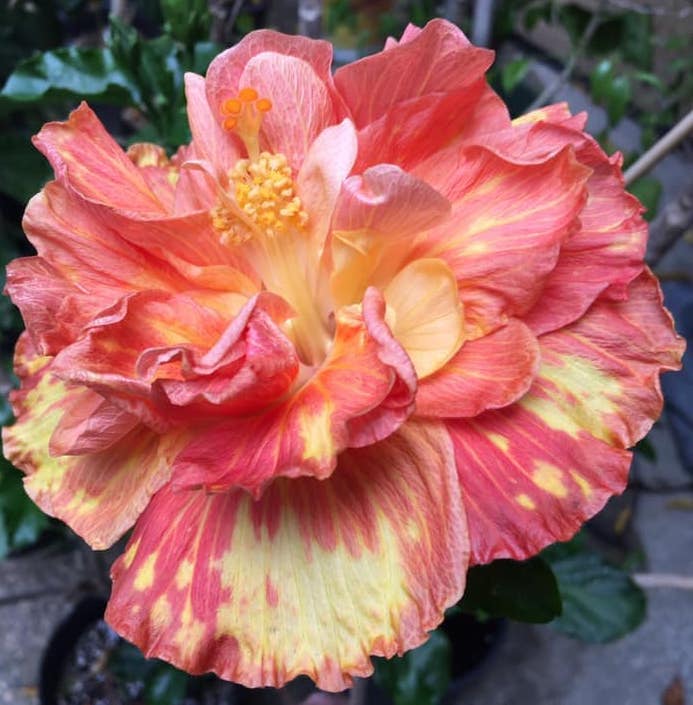
Spice Island by Hidden Valley Hibiscus – photo courtesy of Thomas Narolewski
EXHIBITOR STANDARDS
1. Exhibitors must have plants in their possession for at least 30 days before a bloom from it may be entered in competition at a show.
2. Only one entry per variety per garden is allowed in any one Class. Family members of an exhibitor may only show blooms from plants they grow and maintain themselves. Any duplicate entry of a variety shall result in both blooms being disqualified.
3. The name of the variety must be determined before entering the bloom. The word “unlisted” may be used if reasonable persistence has been attempted and identification has failed.
4. Varieties unknown to Judges, and not described in the Nomenclature, should be judged as if the exhibited bloom is typical for that variety.
5. No unnatural support shall be allowed in displaying blooms, other than the accepted holders. The approved holders are 6” straight wires with a point on one end. This point is inserted into the calyx of the bloom, and the flat end is inserted in the wooden blocks provided. Blooms shall be displayed horizontally with bloom facing upward.
6. An unopened bloom received by the Judges may, if time permits, be returned to the exhibitor and re-entered when properly opened. If, in the opinion of the Judges, time does not permit return and re-entry, the bloom will be marked “not open” indicating it was not judged for an award.
7. If a bloom is exhibited and chosen for a top award, and it is observed closing prior to opening of the show, the bloom will be replaced by the runner-up bloom to win the award. The AHS Show Director will make this decision.
SINGLE
DOUBLE
MINIATURE
WINDMILL
RUFFLED TUFTED CRESTED
OVERLAY OVERLAP REFLEXED
CRIPPLED EYE
ZONE HALO
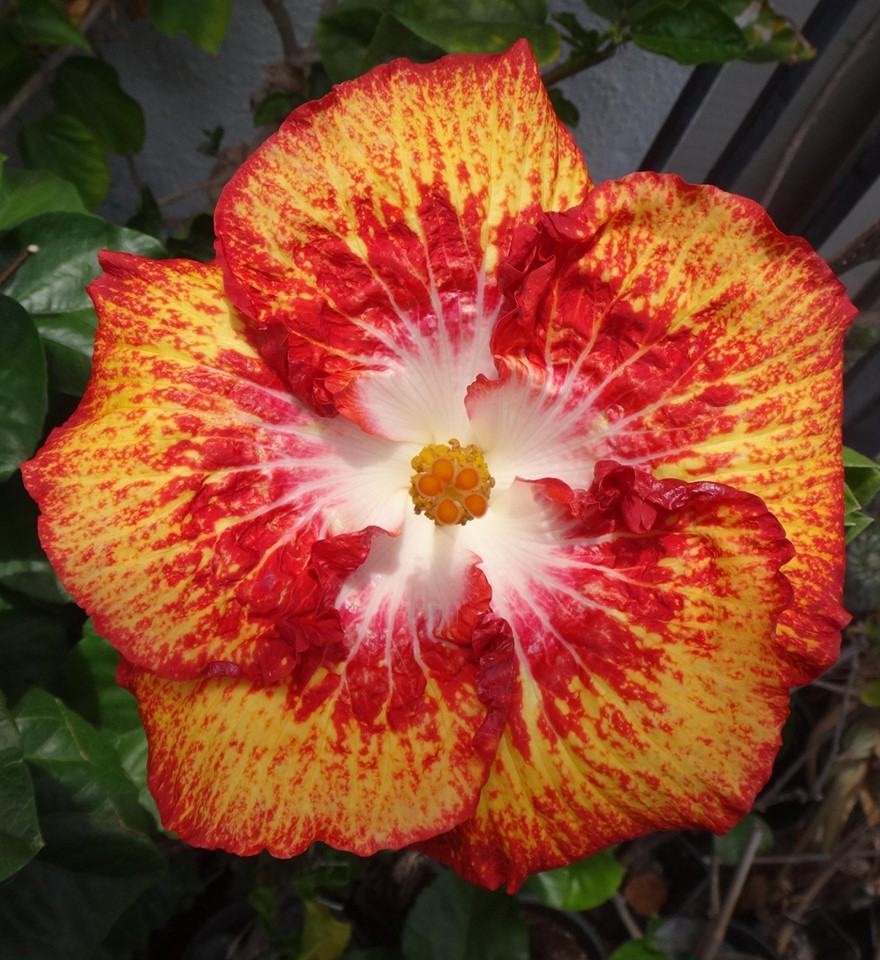
DESCRIPTION DEFINITIONS
A bloom that has a corolla of five base petals and a style, usually with five
stigma pads, with stylar tip secondary petals at times. Stigma pads may be missing on some varieties.
A bloom composed of five base petals with many or few additional petals in a tight or loose formation. Staminal columns and/or stigma pads may be missing or not visible on the outside of the bloom.
Any bloom that is five inches in diameter or less. Miniature blooms must pass through a 5” ring passed straight down over the bloom and not tilted in any way.
A bloom with a separation down the length of the petals symmetrically, not overlapped.
Edges of petals are frilly.
Petals making frilly tufts, usually on overlap of petals.
Petals on the style or staminal column high enough that they are not originating from the base.
Color that appears to be laid over another color. Petal that laps over another petal.
Petals turned downward. Some varieties may reflex when first opened, but become flat later in the day.
Base petal separation or twist that is abnormal for that variety.
The eye or center of the bloom, usually a different color from the rest of the petal. Can be small or quite large, but all one color.
VEINS Lines or streaks of a different color radiating into the body color. Very
often these are white or silver or a different shade of the body color.
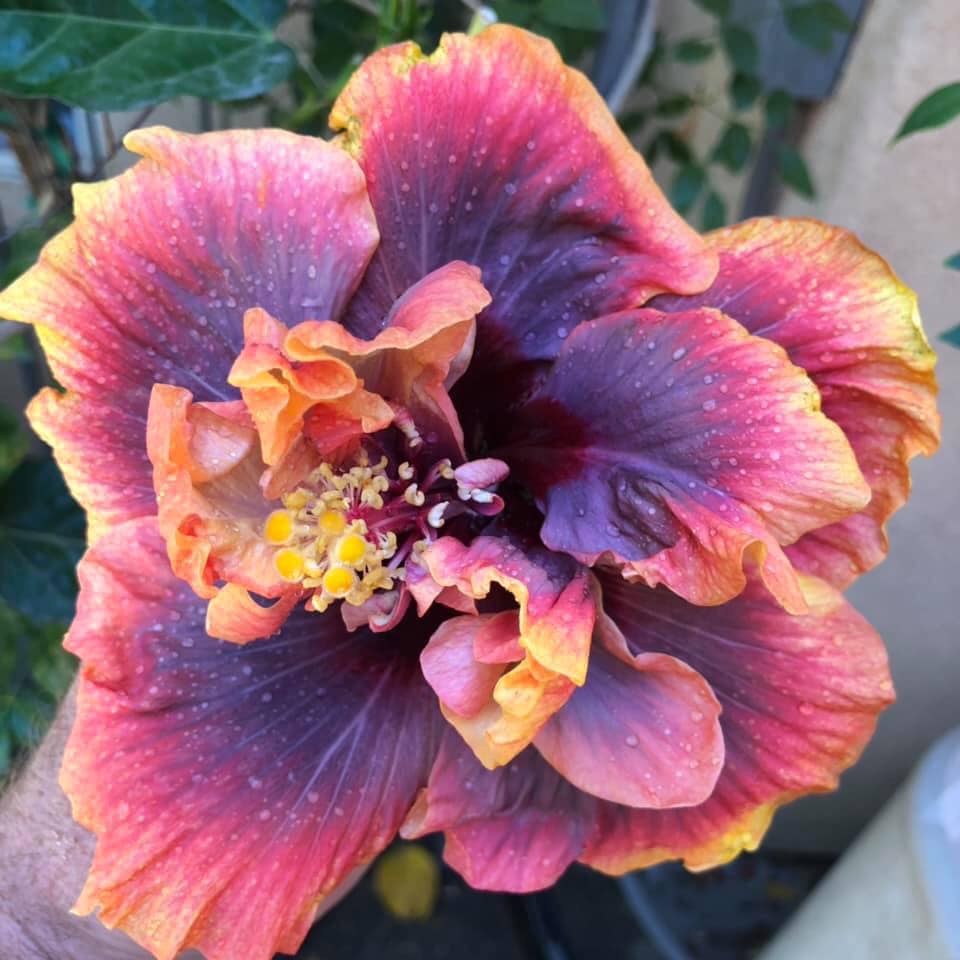
Crown Jellyfish hybridized by Pushpa Suresh – photo courtesy of Thomas Narolewski
ENTRY CLASSES (TAGS)
1. The Classes for entering both single and double blooms are:
a. Amateur: A non-commercial exhibitor showing blooms for two calendar years, with no limitation on number of plants grown.
b. Collector: A non-commercial exhibitor having not more than 75 named
varieties.
c. Open Collector: A non-commercial exhibitor having more than 75 named varieties.
d. Commercial: Any exhibitor that consistently advertises by any means (verbal, visual, print media) that result in conveyance of hibiscus plants or plant material for the exchange of monetary value.
2. The above Classes may also enter blooms as:
a. Miniature: Any bloom five inches or less.
b. Seedling: A new variety of hibiscus not yet released.
c. Miniature Seedling: A new variety of hibiscus five inches or less, not yet released.
3. All exhibitors must be present to enter their blooms, unless there are extenuating circumstances such as illness, and with the prior permission of the Show Director.
The only exception to this rule is seedlings. If an exhibitor is growing a seedling for a hybridizer, the grower may enter the seedling with the hybridizer’s name shown as hybridizer, and the grower’s name as the grower.
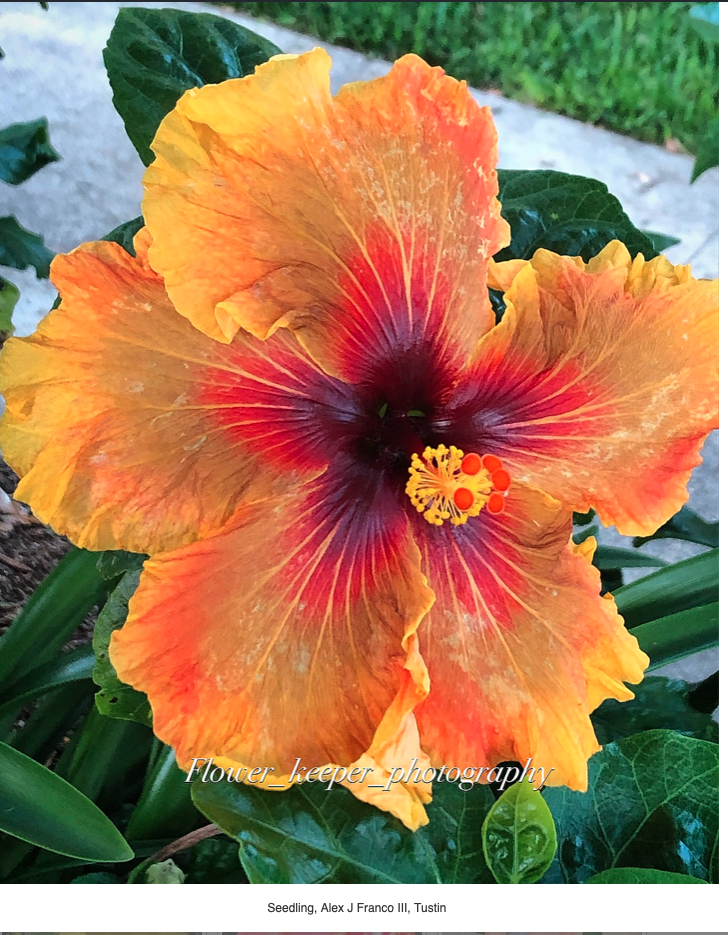
JUDGING SEEDLINGS
1. A new seedling may be shown only five times in a period of no more than five consecutive show years, as a seedling. On an honor system it is the hybridizer’s responsibility to keep track of the number of times his seedlings are shown.
2. If a seedling bloom is entered in an exhibit category as a regular variety by an exhibitor other than the hybridizer, even without the hybridizer’s consent, it can no longer be shown as a seedling.
3. All seedlings will be placed together, by category, i.e., miniature single, regular double, etc., to be judged by all Judges at once.
An area of color different from the eye, but not the same as the body color. This color can be a lighter or darker
4. Judges will abstain from voting in any seedling category or selection of Best of Show Seedling if their bloom is under consideration. Ballots will be marked with an “X” to denote abstention.
5. If, because of abstentions, there is a shortage of Judges for seedling categories, Senior Judges in attendance at a show who are not otherwise judging may, at the discretion of the Show Director, be invited to vote for seedlings. At the discretion of the Show Director, a Senior Judge so invited may continue to vote through the end of final judging in all categories in addition to seedlings. Invited Judges are responsible for signing the Judges’ Attendance Sheet and will be credited with judging activity at that show.
6. When a seedling variety wins “Best of Show Seedling” at any show it shall no longer be shown as a seedling, but then only as a regular variety.
7. It is the responsibility of the hybridizer to mark the seedling entry tag that a bloom is a miniature. Only the hybridizer knows if the bloom is typically five inches or less.
8. In the Seedling Class, minor condition defects should not eliminate awards. No crippled blooms shall receive an award.
9. A seedling must receive a majority vote of the Judges before it can be “Best of Show Seedling.” “Best of Show Seedling” must be registered immediately with at least the basic information of name of bloom, hybridizer, parentage, configuration (single, double, etc.) and color group. The Show Director will furnish the hybridizer with the proper forms for registration with the AHS Nomenclature Chairman. These forms are included in the show packet. Failure to register the winning seedling may result in its being dropped from the evaluation process for Seedling of the Year.
10. Hybridizers will insure that the same identification is used with their cultivar anytime it is exhibited as a seedling in competition. Failure to comply with this rule will result in disqualification of that hybridizer’s cultivars for seedling consideration for one year.
11. Hybridizers will use the seedling entry cards. The name of the hybridizer must be shown on the card. If the seedling is being shown by someone other than the hybridizer, the name of the exhibitor must also be on the entry card.
12. All seedlings must be cloned, either by grafting or rooting, and evaluated by the hybridizer in all seasons before being entered in a show.
13. A sport must be grafted or grown on its own root before being shown.
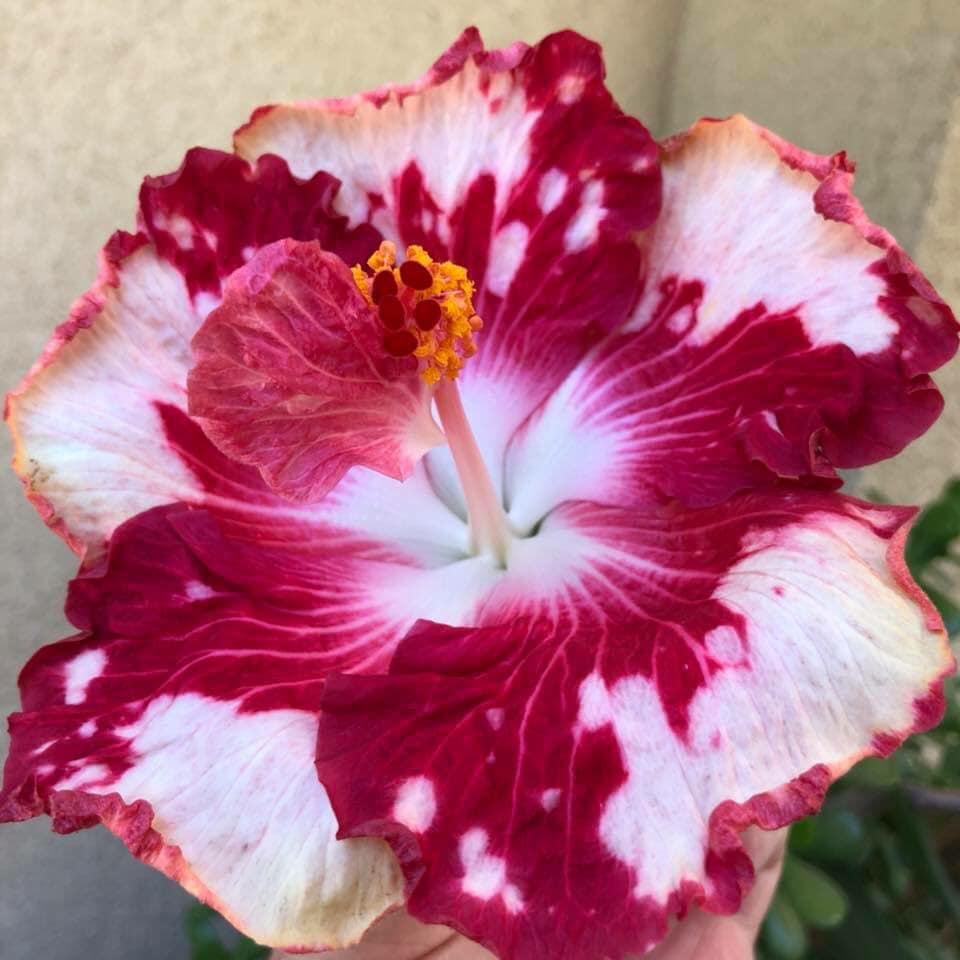
Cherry Appaloosa by Hidden Valley Hibiscus – photo courtesy of Thomas Narolewski
FINAL GOLD SEAL JUDGING
SCHS SHOW DIRECTOR
1. The SCHS Show Director and Assistant Show Director(s):
a. Are appointed by the 1VP prior to the beginning of the show season to be in charge of final Gold Seal judging. All Judges must listen carefully for special instructions at this time.
b. Shall be qualified Senior Judges with at least two years of senior judging experience. A Show Director must have served as an Assistant for three shows prior to serving as a Show Director.
c. Will confer with local Show Chairperson for any extension of the published entry closing time.
d. Will renumber Gold Seal bloom tags and group according to Class for final vote in main show arena.
e. Will give each Judge two tri-color ballots (one for Seedlings and one for the other Classes) marked for voting for Best Single and Double in each of the seven Classes. These votes will be tabulated away from the Judges on a special tri-color tally sheet. Blank note paper will be used as ballots to break tie votes when necessary.
f. Will assemble the bloom winners from the above vote and give Judges a ballot for selection of the “Best of Show” blooms from this group.
g. Will remove the “Best of Show” blooms to the awards table. The runner-up in each Class will replace the “Best of Show” bloom in each Class. EXCEPTION: The “Best of Show Seedling” will not be replaced. Seedlings never move up.
h. Will officially dismiss all the Judges when final judging is completed.
2. Determination of “Best of Category” and “Best of Show” will be on plurality basis— blooms receiving the highest number of votes plus one. A seedling must receive a majority vote of the Judges before it can be “Best of Show Seedling.”
3. The Show Director will resolve any question concerning judging, make final determinations and insure adherence to SCHS standards and rules in the Gold Seal Area.
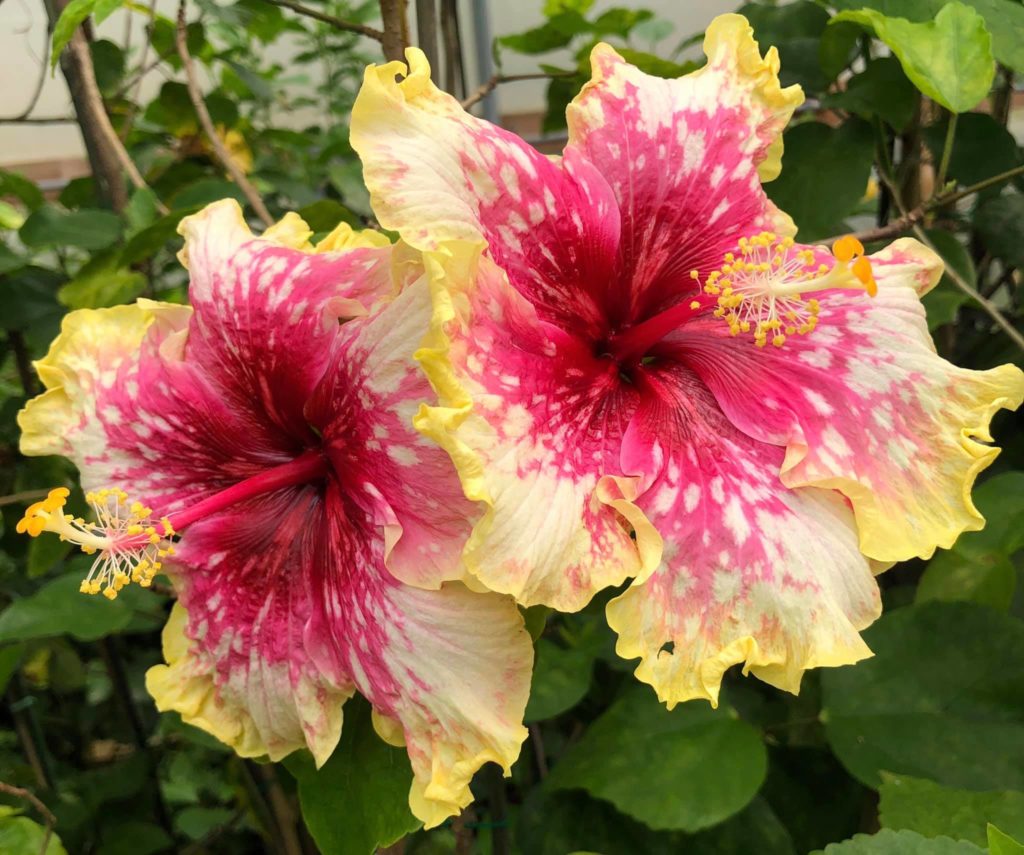
Night Runner x Maui Masterpiece by Todd Alvis
FINAL GOLD SEAL JUDGING
TRI-COLOR BALLOTING
1. The judging for all tri-color awards is by secret ballot.
2. All Judges must vote in all categories from the available Gold Seal selections.
EXCEPTION: Seedlings. If a Judge feels there is no worthy seedling in a category or categories, he may choose a “No Vote” or “X” in that category(ies). If a majority of Judges marks their ballot “No Vote,” a bloom cannot become Best of Show Seedling.
Also, note the exception that a Judge may not vote in a Seedling Classification in which he has a bloom in competition (see Page 11, Item 4).
A Judge may not vote in any category in which he/she has a bloom in competition. Ballots will be marked “no vote.”
This does not apply to the Miniature Class.
3. A tri-color bloom shall receive a plurality vote. The bloom receiving the highest number of votes, and one more than the nearest competitor, will be declared the winner. In case of a deadlock, defined as two run-offs, the Show Director and Assistant(s) will cast the deciding votes.
4. Judges must stay in the final judging area until all judging is completed and they are dismissed by the SCHS Show Director.
5. The only time that personal preference for a bloom is allowed in judging is during the tri-color balloting.
Miniature
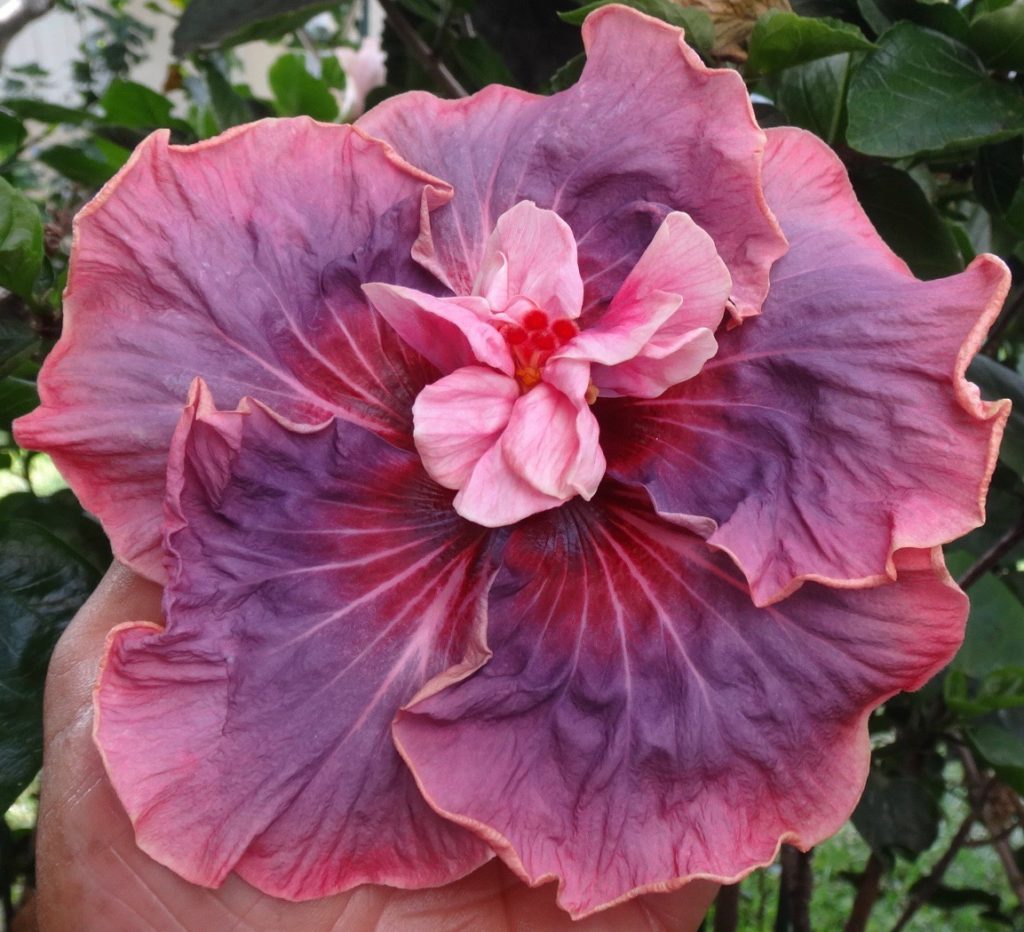
Tahitian Seedling hybridized by Richard Johnson
FINAL GOLD SEAL JUDGING
MANDATORY TRI-COLORS
1. When Gold Seals are available in the Class, voting will take place in the following categories:
a. Single and Double:
Amateur Collector
Open Collector
Commercial
Miniature
Regular Seedling
Miniature Seedling
b. Best of Show:
Single
Double
Seedling
Miniature Seedling
2. The four Sweepstakes winners are also awarded tri-colors
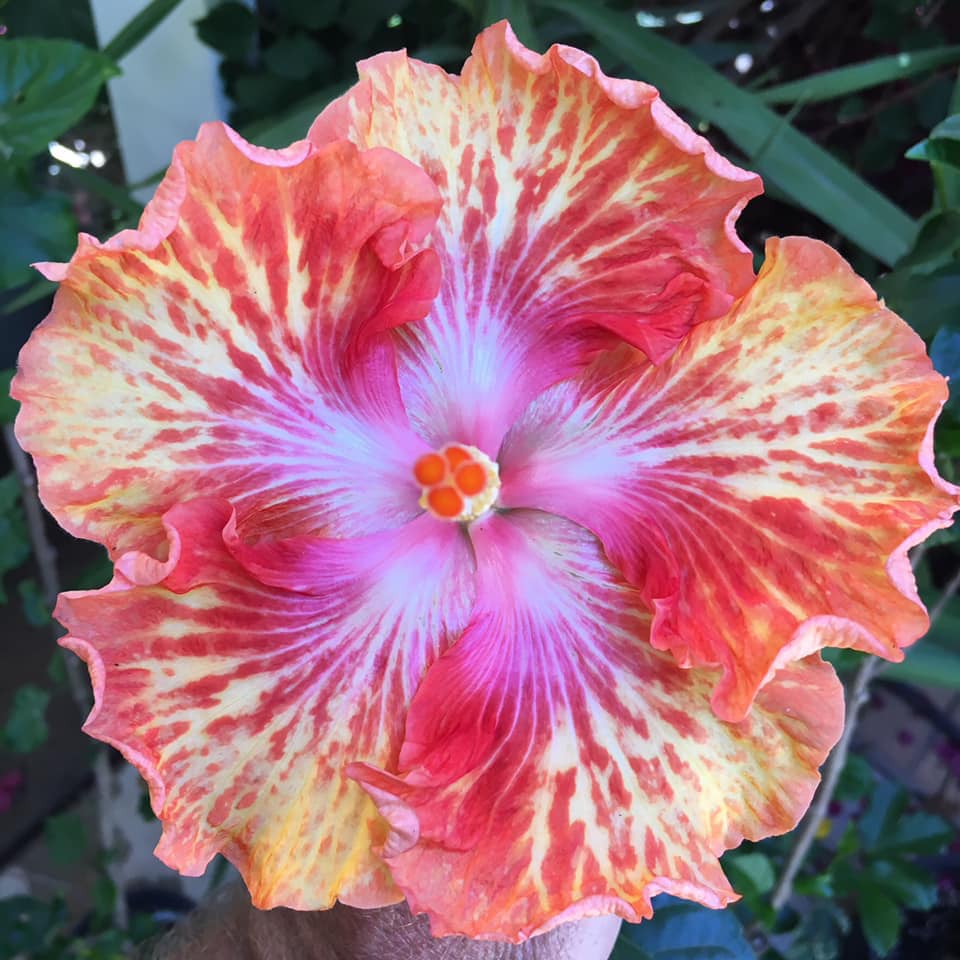
Energy Blast by Hidden Valley Hibiscus – photo courtesy of Thomas Narolewski
SWEEPSTAKES
- Judges do not vote for Sweepstakes awards. These are tabulated according to classification from the Judge Clerk’s tally sheets by the SCHS Executive Secretary or representative, and a local Chapter designee, on special tally sheets. Sweepstakes awards are determined by counting the number of Gold Seals won by each exhibitor in each of the four classifications (Amateur, Collector, Open Collection and Commercial). If there is a tie in any one or more of the classifications, the number of Blue Ribbons is counted to determine a clear winner. This tally is completed during Gold Seal judging; results are given to the Chapter Show Chairman.
2. Seedlings are not to be included in Sweepstakes tally.
3. The Sweepstakes tally indicates winners in each of four entry classes (Amateur,
Collector, Open Collector, Commercial) having the most Gold Seal awards.
4. If an error in Gold Seal tallying is noticed and confirmed:
a. BEFORE opening the show to the public, the error will be immediately corrected by the Show Director and/or whatever National Officer or Director is available.
b. AFTER the show opens to the public, common sense and decorum must prevail. If the error can be corrected quietly and tactfully and without undue public notice, then the Show Director and/or an Officer or Director should make the correction. If such correction would cause undue public notice, appearance of disorganization, amateurism, or confusion, the outward appearance of the Head Table should not be disturbed.
c. In either case, any error should be reported to either the 1VP or Executive Secretary so that show records may be checked and, if warranted, adjustment made in the yearly Sweepstakes tally.